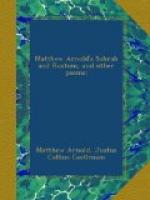=58. Berkshire moors=. Berkshire is the county, or shire, on the south of Oxford County.
=69. green-muffled=. Explain the epithet.
[199]
=74. Bablockhithe=. A small town some four
miles west and a little south of Oxford, on the Thames,
which at that point is a mere stream crossed by a
ferry. This and numerous other points of interest
in the vicinity of Oxford are frequented by Oxford
students; hence Arnold’s familiarity with them
and his reference to them in this poem and Thyrsis.
See any atlas.
=79. Wychwood bowers=. That is, Wychwood Forest, ten or twelve miles north and west of Oxford. See note, l. 74.
=83. To dance around the Fyfield elm in May=. Fyfield, a parish in Berkshire, about six miles southwest of Oxford. The reference here is to the “May-day” celebrations formerly widely observed in Europe, but now nearly disappeared. The chief features of the celebration in Great Britain are the gathering of hawthorn blossoms and other flowers, the crowning of the May-queen and dancing around the May-pole—here the Fyfield elm. See note, l. 74. Read Tennyson’s poem, The Queen o’ the May.
=91. Godstow Bridge=. Some two miles up the Thames from Oxford.
=95. lasher pass=. An English term corresponding to our mill race. The lasher is the dam, or weir.
=98. outlandish=. Analyze the word and determine meaning.
=111. Bagley Wood=. South and west of Oxford, beyond South Hinksey. See note, l. 125; also note, l. 74.
=114. tagg’d=. That is, marked; the leaves being colored by frost.
=115. Thessaly=. The northeastern district of ancient Greece, celebrated in mythology. Here a forest ground near Bagley Wood. See note, l. 111; also note, l. 74.
=125. Hinksey=. North and South Hinksey
are unimportant villages a short distance out from
Oxford in the Cumnor Hills. See note, l. 74.
[200]
=129. Christ Church hall=. The largest and
most fashionable college in Oxford; founded by Cardinal
Wolsey in 1525. The chapel of Christ Church is
also the cathedral of the diocese of Oxford.
=130. grange=. Consult dictionary.
=133. Glanvil=. Joseph Glanvil, 1636-1680. A noted English divine and philosopher; author of a defence of belief in witchcraft.
=140. red-fruited yew tree=. The yew tree is very common in English burial-grounds. It grows slowly, lives long, has a dark, thick foliage, and yields a red berry. See Wordsworth’s celebrated poem, The Yew-Tree.
=141-170=. “This note of lassitude is struck often—perhaps too often—in Arnold’s poems.”—DU PONT SYLE. See also The Stanzas in Memory of the Author of Obermann. For the author’s less despondent mood, see his Rugby Chapel, included in this volume.




